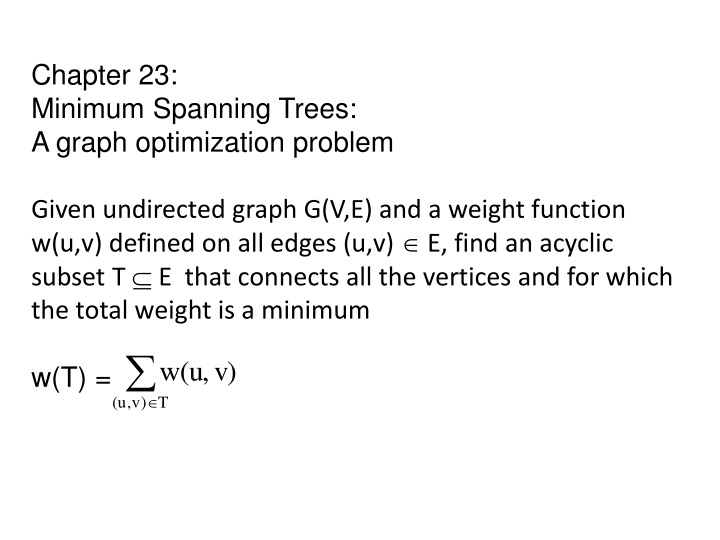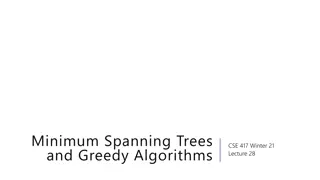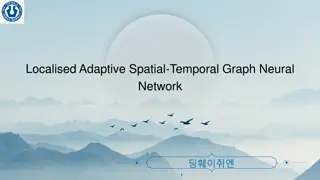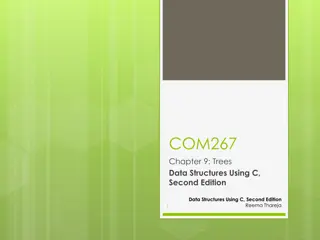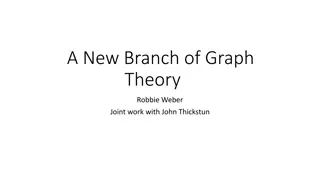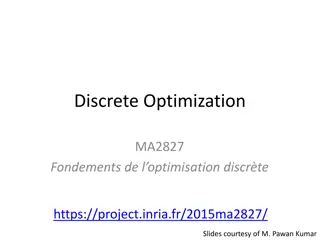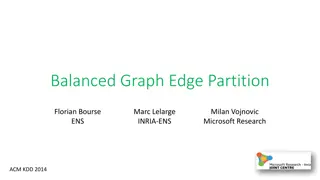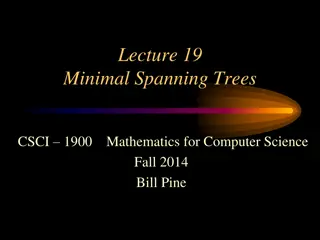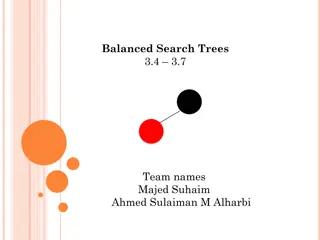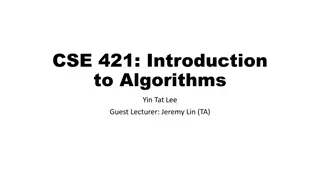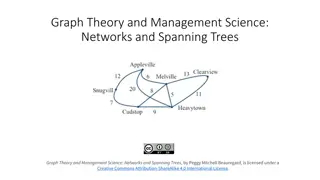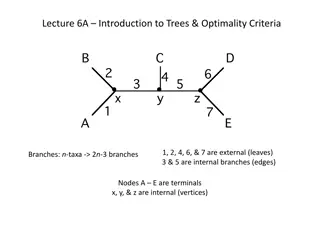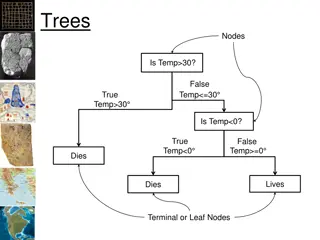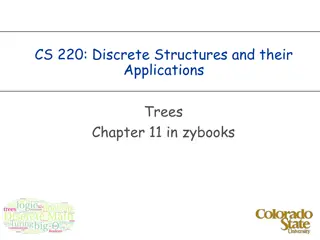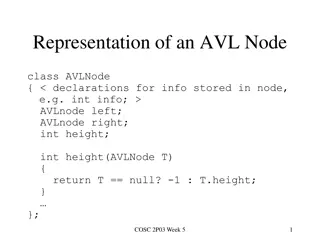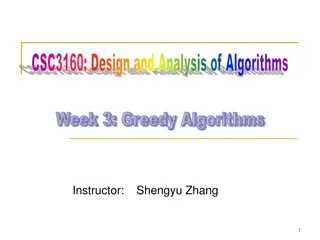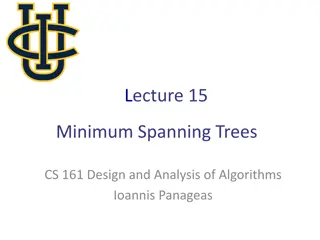Minimum Spanning Trees: Graph Optimization Problem
A graph optimization problem focusing on finding an acyclic subset in an undirected graph that connects all vertices with minimal total weight. This involves exploring Kruskal's and Prim's algorithms for solving the minimum spanning tree problem by leveraging safe edges and cuts. The concept of growing a minimum spanning tree is explained through the rule of finding safe edges related to cuts and partitions of vertices. The theorem provided offers insights into identifying safe edges for a growing MST.
Uploaded on Feb 20, 2025 | 0 Views
Download Presentation

Please find below an Image/Link to download the presentation.
The content on the website is provided AS IS for your information and personal use only. It may not be sold, licensed, or shared on other websites without obtaining consent from the author.If you encounter any issues during the download, it is possible that the publisher has removed the file from their server.
You are allowed to download the files provided on this website for personal or commercial use, subject to the condition that they are used lawfully. All files are the property of their respective owners.
The content on the website is provided AS IS for your information and personal use only. It may not be sold, licensed, or shared on other websites without obtaining consent from the author.
E N D
Presentation Transcript
Chapter 23: Minimum Spanning Trees: A graph optimization problem Given undirected graph G(V,E) and a weight function w(u,v) defined on all edges (u,v) E, find an acyclic subset T E that connects all the vertices and for which the total weight is a minimum w(T) = w(u, v) T (u, v)
Any acyclic subset T E that connects all the vertices is a spanning tree. Any T with minimum total weight is a minimum-weight spanning tree. Most often called minimum spanning tree
Chapter 23 covers 2 approaches for solving the minimum spanning tree problem; Kruskal salgorithm and Prim s algorithm. Both are examples of greedy algorithms (no global search strategy) Generic greedy MST(G,w) A = null set while A is not a minimum spanning tree add the lightest edge unless it generates a cycle (trees are acyclic graphs)
Growing a minimum spanning tree (MST): G(V,E) is an undirected graph. A is subset of V that defines part of a MST. edge (u,v) is a safe edge if A (u,v) is also part of a MST. Kruskal and Prim algorithms differ in how they search for safe edges. Safe edges are defined by cuts .
Theorem 23.1(next slide) provides a rule for finding safe edges A cut (S,V-S) is a partition of vertices in G(V,E) Edge (u,v) crosses cut (S,V-S) if one end is in S and the other is V-S A cut respects set A if no edge in A crosses the cut An edge that crosses a cut is a light edge if it has the minimum weight of edges crossing the cut Edges in A are shaded. White and black V s are in different parts of partition. (c,d) is a light edge and a safe edge for growing MST.
Let (S,V-S) be a cut in G that respects A, a growing MST. Let (u,v) be a light edge crossing (S,V-S). Then (u,v) is a safe edge for A. Theorem 23.1 Proof: Let T be a MST that contains A (shaded) and (x,y) but not (u,v). Both(u,v) and (x,y) cross (S, V-S) (connect B&W vertices). Define T = {T (x,y)} {(u,v)} w(u,v) < w(x,y) because (u,v) is a light edge w(T ) = w(T) w(x,y) + w(u,v) < w(T) but T is a MST w(T) < w(T ) w(T ) must also be a MST (u,v) is a safe edge for A
Corollary 23.2: G(V,E) a is connected, undirected, weighted graph. A is a subset of E that is included in some MST of G. GA (V,A) is a forest of connected components (VC,EC), each of which is a tree. If (u,v) is a light edge connecting C to some other component of A, then (u,v) is a safe edge of A Proof: cut (VC, V-VC) respects A and crosses (u,v) (u,v) is a safe edge by Theorem 23.1
Corrllary 23.2 is basis for Krustal algorithm Look for a cut that respects the growing MST, A, and crosses the lightest edge not already in A. If such a cut exists, include lightest edge in A; otherwise repeat with next lightest edge. Repeat until all vertices are in the MST
Steps in Krustals Algorithm Sometimes you can t add the light edge (no cut or will create a cycle)
Final steps in Krustals algorithm All vertices connected
Pseudo-code for Krustals algorithm: p 569 Uses operations on disjoint-set data structures that are described in Chapter 21, p499. the representative of that set. Make-Set(x) creates a new distinct set whose only member, x, is set that contains element x. Find-Set(x) returns a pointer to the representative of the unique and y, respectively. Chooses a representative for Sx Sy and destroys Sx and Sy Union-Set(x,y) unites the sets Sx and Sy that contain elements x
MST-Kruskal(G,w) (initialization) (process edges in sorted order) for all edges (u,v) return A Running time: Sorting edges by weight takes O(E lgE) (most time-consuming step) A 0 for each v V[G] do Make-Set(v) sort edges E[G] in non-decreasing order by weight do if Find-Set(u) Find-Set(v) (vertices u and v are in different trees) then A A {(u,v)} Union-Set(u,v) Disjoint-set operations (21.3 p505-509) O((E+V)lgV) Total O(ElgE + (E+V)lgV) -> O(ElgE) if E >> V
Rationale of Prims algorithm: Starts from an arbitrary root. At each step, consider all edges that connect the growing MST, A, to a vertex not already in the tree. Add the lightest of these if it is a safe edge (i.e., does not create a cycle). In hand calculation, resolve any ambiguity by alphabetical order of vertices in A. As MST is built, record p[v] if ask to draw the final MST.
Krustal A is root. Record p(v) Prim
Completes solution by Prim s algorithm
MST-Prim(G,w,r) (initialization completed) while Q 0 (get the external vertex with the lightest connecting edge) for each v Adj[u] (update the fields of all vertices that are adjacent to u but not in the tree) Performance of Prim: (assuming Q is a binary min-heap) Build-Min-Heap requires O(V) time while Q 0 loop executes |V| times Extract-Min operations take total O(V lgV) time body of the for loop over adjacency lists executes |E| times Q membership test can be implemented in constant time Decrease-Key to update key[v] requires O(lgV) time for each u V[G] key[r] 0 Q V[G] dokey[u] , p[v] NIL do u Extract-Min(Q) do if v Q and w(u,v) < key[v] then p[v] u, key[v] w(u,v) Total time O((V + E)lgV ) same as disjoint-set operations in Krustal
Implementation of Prims algorithm: Start from an arbitrary root. At each step, add a light edge that connects growing MST to a vertex not already in the tree. (a safe edges by Corollary 23.2) To facilitate selection of new edges, maintain a minimum priority queue of vertices not in the growing MST. key[v], which defines the priority of v, is the minimum weight among all the edges that connect v to any vertex in the current MST. key[v] = if no such edge exist. Algorithm terminates when queue is empty. {(v, p[v]): v V {r} Q} implicitly defines the growing MST = A
Assignment 20 Use the rationale of Prim s algorithm to find an MST in the graph below. Resolve ambiguity about the order of vertex addition by alphabetical order. Use vertex h as the root. As vertices are added, record their predecessor. Use this information to draw the MST. 18 7 a c b 5 4 9 g 11 h 2 14 8 6 10 e f d 1 3
